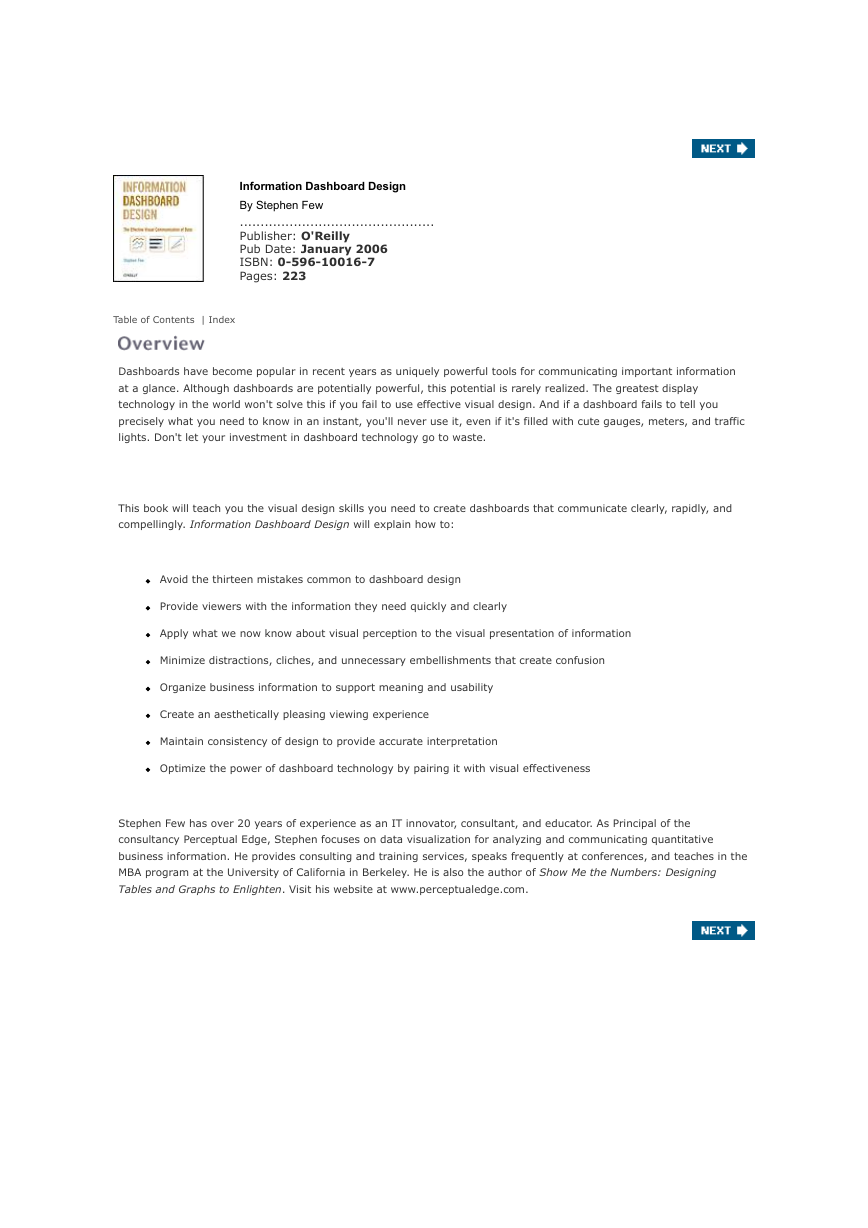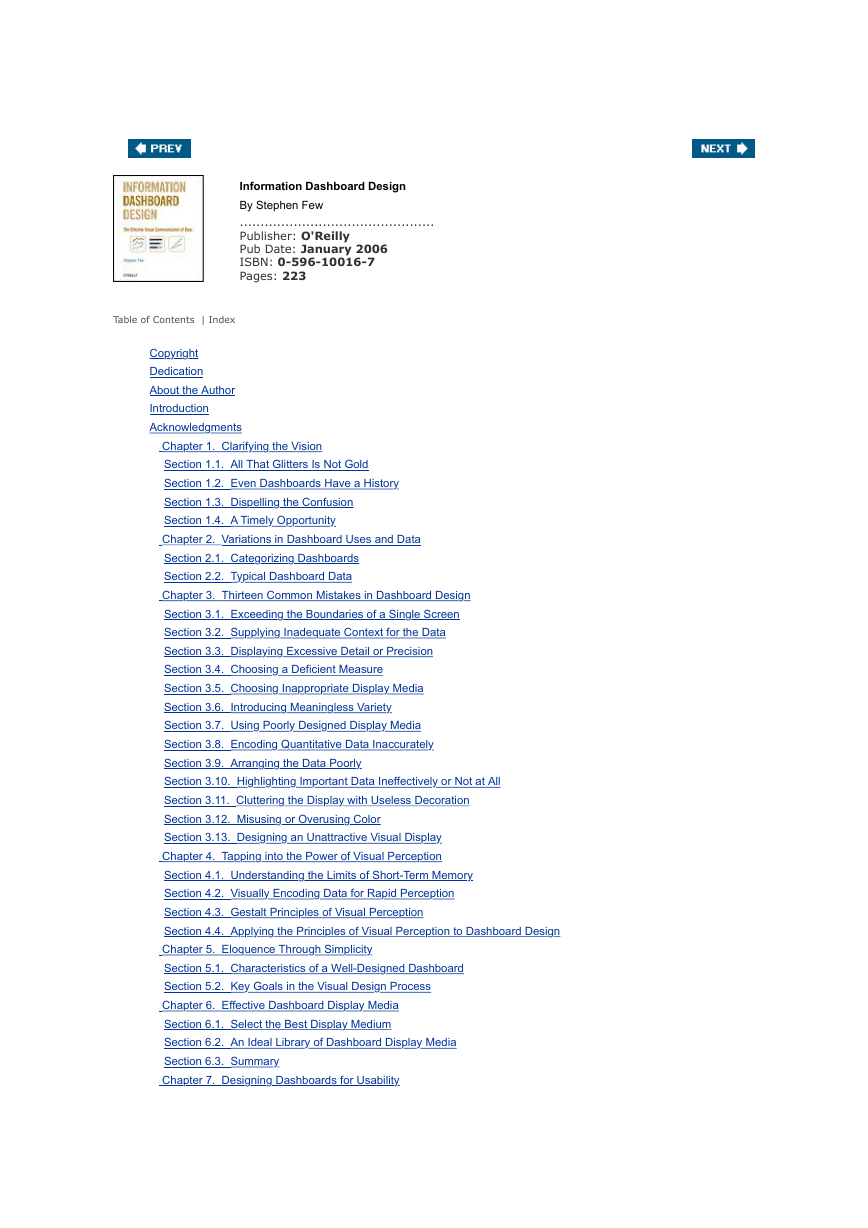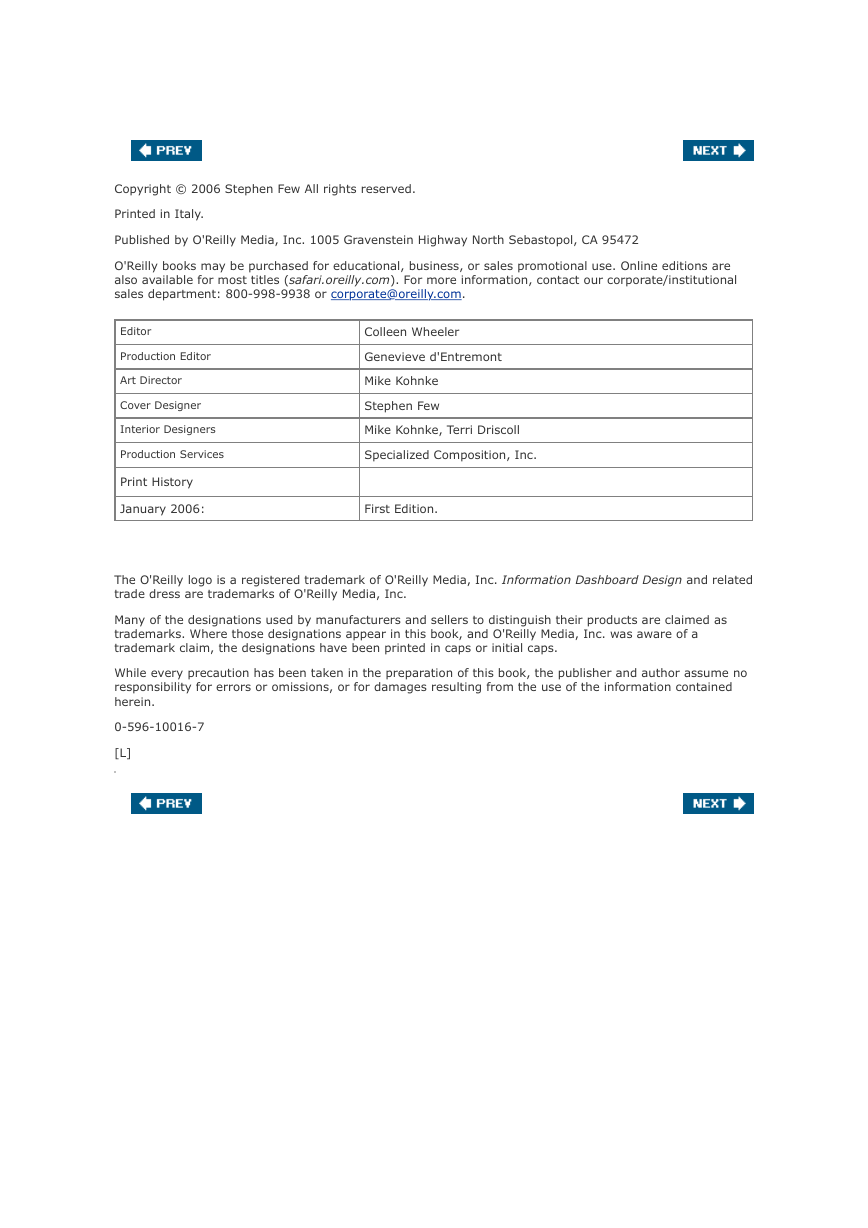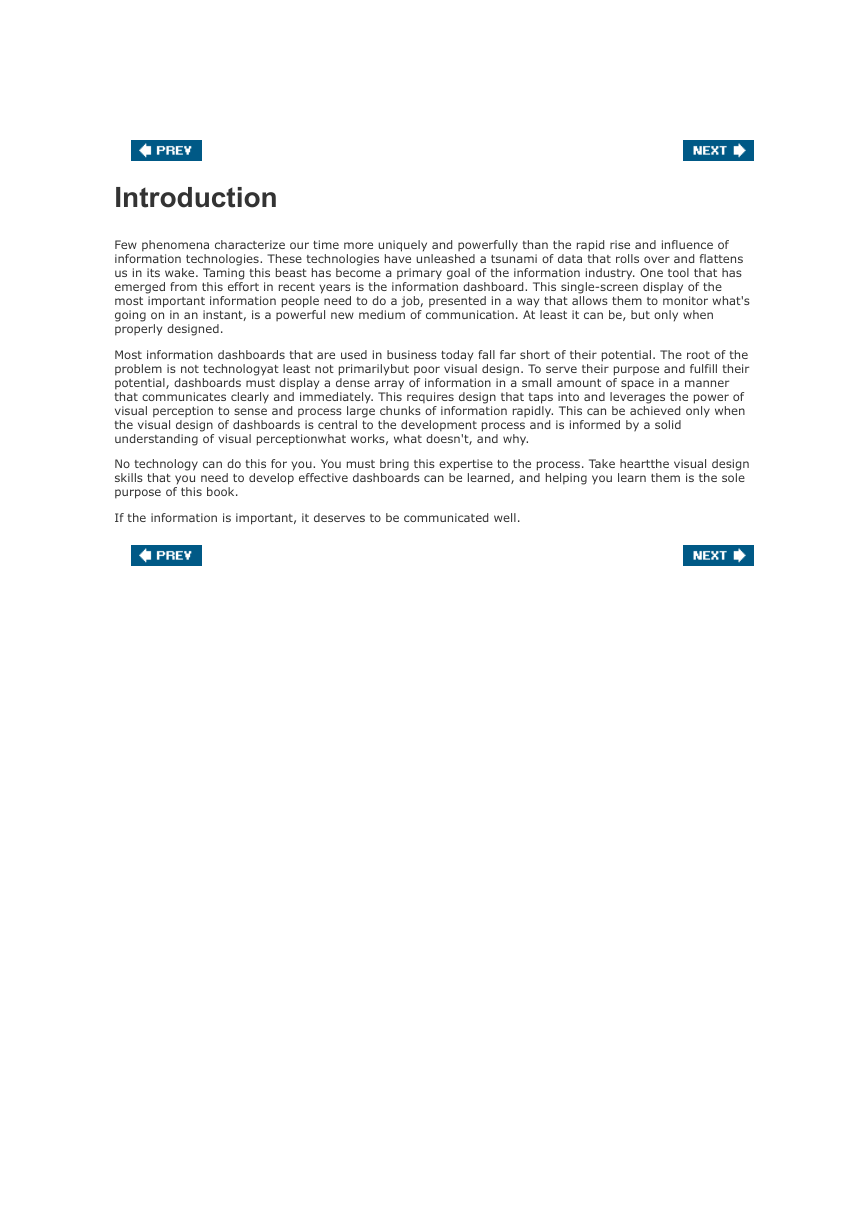Information Dashboard Design
By Stephen Few
...............................................
Publisher: O'Reilly
Pub Date: January 2006
ISBN: 0-596-10016-7
Pages: 223
Table of Contents | Index
Dashboards have become popular in recent years as uniquely powerful tools for communicating important information
at a glance. Although dashboards are potentially powerful, this potential is rarely realized. The greatest display
technology in the world won't solve this if you fail to use effective visual design. And if a dashboard fails to tell you
precisely what you need to know in an instant, you'll never use it, even if it's filled with cute gauges, meters, and traffic
lights. Don't let your investment in dashboard technology go to waste.
This book will teach you the visual design skills you need to create dashboards that communicate clearly, rapidly, and
compellingly. Information Dashboard Design will explain how to:
Avoid the thirteen mistakes common to dashboard design
Provide viewers with the information they need quickly and clearly
Apply what we now know about visual perception to the visual presentation of information
Minimize distractions, cliches, and unnecessary embellishments that create confusion
Organize business information to support meaning and usability
Create an aesthetically pleasing viewing experience
Maintain consistency of design to provide accurate interpretation
Optimize the power of dashboard technology by pairing it with visual effectiveness
Stephen Few has over 20 years of experience as an IT innovator, consultant, and educator. As Principal of the
consultancy Perceptual Edge, Stephen focuses on data visualization for analyzing and communicating quantitative
business information. He provides consulting and training services, speaks frequently at conferences, and teaches in the
MBA program at the University of California in Berkeley. He is also the author of Show Me the Numbers: Designing
Tables and Graphs to Enlighten. Visit his website at www.perceptualedge.com.
�
Information Dashboard Design
By Stephen Few
...............................................
Publisher: O'Reilly
Pub Date: January 2006
ISBN: 0-596-10016-7
Pages: 223
Table of Contents | Index
Copyright
Dedication
About the Author
Introduction
Acknowledgments
Chapter 1. Clarifying the Vision
Section 1.1. All That Glitters Is Not Gold
Section 1.2. Even Dashboards Have a History
Section 1.3. Dispelling the Confusion
Section 1.4. A Timely Opportunity
Chapter 2. Variations in Dashboard Uses and Data
Section 2.1. Categorizing Dashboards
Section 2.2. Typical Dashboard Data
Chapter 3. Thirteen Common Mistakes in Dashboard Design
Section 3.1. Exceeding the Boundaries of a Single Screen
Section 3.2. Supplying Inadequate Context for the Data
Section 3.3. Displaying Excessive Detail or Precision
Section 3.4. Choosing a Deficient Measure
Section 3.5. Choosing Inappropriate Display Media
Section 3.6. Introducing Meaningless Variety
Section 3.7. Using Poorly Designed Display Media
Section 3.8. Encoding Quantitative Data Inaccurately
Section 3.9. Arranging the Data Poorly
Section 3.10. Highlighting Important Data Ineffectively or Not at All
Section 3.11. Cluttering the Display with Useless Decoration
Section 3.12. Misusing or Overusing Color
Section 3.13. Designing an Unattractive Visual Display
Chapter 4. Tapping into the Power of Visual Perception
Section 4.1. Understanding the Limits of Short-Term Memory
Section 4.2. Visually Encoding Data for Rapid Perception
Section 4.3. Gestalt Principles of Visual Perception
Section 4.4. Applying the Principles of Visual Perception to Dashboard Design
Chapter 5. Eloquence Through Simplicity
Section 5.1. Characteristics of a Well-Designed Dashboard
Section 5.2. Key Goals in the Visual Design Process
Chapter 6. Effective Dashboard Display Media
Section 6.1. Select the Best Display Medium
Section 6.2. An Ideal Library of Dashboard Display Media
Section 6.3. Summary
Chapter 7. Designing Dashboards for Usability
�
Section 7.1. Organize the Information to Support Its Meaning and Use
Section 7.2. Maintain Consistency for Quick and Accurate Interpretation
Section 7.3. Make the Viewing Experience Aesthetically Pleasing
Section 7.4. Design for Use as a Launch Pad
Section 7.5. Test Your Design for Usability
Chapter 8. Putting It All Together
Section 8.1. Sample Sales Dashboard
Section 8.2. Sample CIO Dashboard
Section 8.3. Sample Telesales Dashboard
Section 8.4. Sample Marketing Analysis Dashboard
Section 8.5. A Final Word
Appendix A. Recommended Reading
Colophon
Index
�
Copyright © 2006 Stephen Few All rights reserved.
Printed in Italy.
Published by O'Reilly Media, Inc. 1005 Gravenstein Highway North Sebastopol, CA 95472
O'Reilly books may be purchased for educational, business, or sales promotional use. Online editions are
also available for most titles (safari.oreilly.com). For more information, contact our corporate/institutional
sales department: 800-998-9938 or corporate@oreilly.com.
Editor
Production Editor
Art Director
Cover Designer
Interior Designers
Production Services
Print History
January 2006:
Colleen Wheeler
Genevieve d'Entremont
Mike Kohnke
Stephen Few
Mike Kohnke, Terri Driscoll
Specialized Composition, Inc.
First Edition.
The O'Reilly logo is a registered trademark of O'Reilly Media, Inc. Information Dashboard Design and related
trade dress are trademarks of O'Reilly Media, Inc.
Many of the designations used by manufacturers and sellers to distinguish their products are claimed as
trademarks. Where those designations appear in this book, and O'Reilly Media, Inc. was aware of a
trademark claim, the designations have been printed in caps or initial caps.
While every precaution has been taken in the preparation of this book, the publisher and author assume no
responsibility for errors or omissions, or for damages resulting from the use of the information contained
herein.
0-596-10016-7
[L]
�
Dedication
To my parents, Bob and Joyce Few, whose pride in my journeyhowever
strange that journey must have sometimes seemedinstilled deep down into
my bones the resolve to keep placing one foot in front of the other.
�
About the Author
Stephen Few has over 20 years of experience as an IT innovator, consultant, and
educator. Today, as Principal of the consultancy Perceptual Edge, Stephen focuses on data visualization for
analyzing and communicating quantitative business information. He is working to raise consciousness and
to provide a treatment plan that addresses the needs of business in the language of business. His previous
book, Show Me the Numbers: Designing Tables and Graphs to Enlighten, is a powerful fitness program
designed to target the data presentation aspects of this problem.
Today, from his office in Berkeley, California, Stephen provides consulting and training services, speaks
frequently at conferences, and teaches in the MBA program at the University of California in Berkeley. More
about his current work can be found at www.perceptualedge.com.
�
Introduction
Few phenomena characterize our time more uniquely and powerfully than the rapid rise and influence of
information technologies. These technologies have unleashed a tsunami of data that rolls over and flattens
us in its wake. Taming this beast has become a primary goal of the information industry. One tool that has
emerged from this effort in recent years is the information dashboard. This single-screen display of the
most important information people need to do a job, presented in a way that allows them to monitor what's
going on in an instant, is a powerful new medium of communication. At least it can be, but only when
properly designed.
Most information dashboards that are used in business today fall far short of their potential. The root of the
problem is not technologyat least not primarilybut poor visual design. To serve their purpose and fulfill their
potential, dashboards must display a dense array of information in a small amount of space in a manner
that communicates clearly and immediately. This requires design that taps into and leverages the power of
visual perception to sense and process large chunks of information rapidly. This can be achieved only when
the visual design of dashboards is central to the development process and is informed by a solid
understanding of visual perceptionwhat works, what doesn't, and why.
No technology can do this for you. You must bring this expertise to the process. Take heartthe visual design
skills that you need to develop effective dashboards can be learned, and helping you learn them is the sole
purpose of this book.
If the information is important, it deserves to be communicated well.
�
Acknowledgments
Without a doubt I owe the greatest debt of gratitude to the many software vendors who have done so much
to make this book necessary by failing to address or even contemplate the visual design needs of
dashboards. Their kind disregard for visual design has given me focus, ignited my passion, and guaranteed
my livelihood for years to come.
Now, on to those who have contributed more directly and personally to this effort. As a man, I will never be
able to create, shelter, and nourish an emerging life within this body of mine. In recent years, however, I
have recognized and pursued the opportunity to breathe life into the products of my imagination and pass
them on to the world in the form of books. Writing a book is a bit like bearing a child. Working with a
publisher to help the child learn to walk before venturing into the world is a lesson in trust. The folks at
O'Reilly Media have taught me to entrust to thembeginning with unspeakable angst, but proceeding through
unfaltering steps toward ever-increasing comfortthe collegial care of this beloved child. Many at O'Reilly
have contributed so much, but two in particular have stood by my side from the beginning with soothing
voices of confidence and calm. My editor, Colleen Wheeler, knew when to listen in silence, when to tease me
out of myopia, and when to gently remind me that I was in her considerate and considerable care. My
acquisitions editor, Steve Weiss, sought me out and wooed me through months of thoughtful discussion into
the O'Reilly fold. He gave assurances and has made sure that they were fulfilled.
�
















 2023年江西萍乡中考道德与法治真题及答案.doc
2023年江西萍乡中考道德与法治真题及答案.doc 2012年重庆南川中考生物真题及答案.doc
2012年重庆南川中考生物真题及答案.doc 2013年江西师范大学地理学综合及文艺理论基础考研真题.doc
2013年江西师范大学地理学综合及文艺理论基础考研真题.doc 2020年四川甘孜小升初语文真题及答案I卷.doc
2020年四川甘孜小升初语文真题及答案I卷.doc 2020年注册岩土工程师专业基础考试真题及答案.doc
2020年注册岩土工程师专业基础考试真题及答案.doc 2023-2024学年福建省厦门市九年级上学期数学月考试题及答案.doc
2023-2024学年福建省厦门市九年级上学期数学月考试题及答案.doc 2021-2022学年辽宁省沈阳市大东区九年级上学期语文期末试题及答案.doc
2021-2022学年辽宁省沈阳市大东区九年级上学期语文期末试题及答案.doc 2022-2023学年北京东城区初三第一学期物理期末试卷及答案.doc
2022-2023学年北京东城区初三第一学期物理期末试卷及答案.doc 2018上半年江西教师资格初中地理学科知识与教学能力真题及答案.doc
2018上半年江西教师资格初中地理学科知识与教学能力真题及答案.doc 2012年河北国家公务员申论考试真题及答案-省级.doc
2012年河北国家公务员申论考试真题及答案-省级.doc 2020-2021学年江苏省扬州市江都区邵樊片九年级上学期数学第一次质量检测试题及答案.doc
2020-2021学年江苏省扬州市江都区邵樊片九年级上学期数学第一次质量检测试题及答案.doc 2022下半年黑龙江教师资格证中学综合素质真题及答案.doc
2022下半年黑龙江教师资格证中学综合素质真题及答案.doc